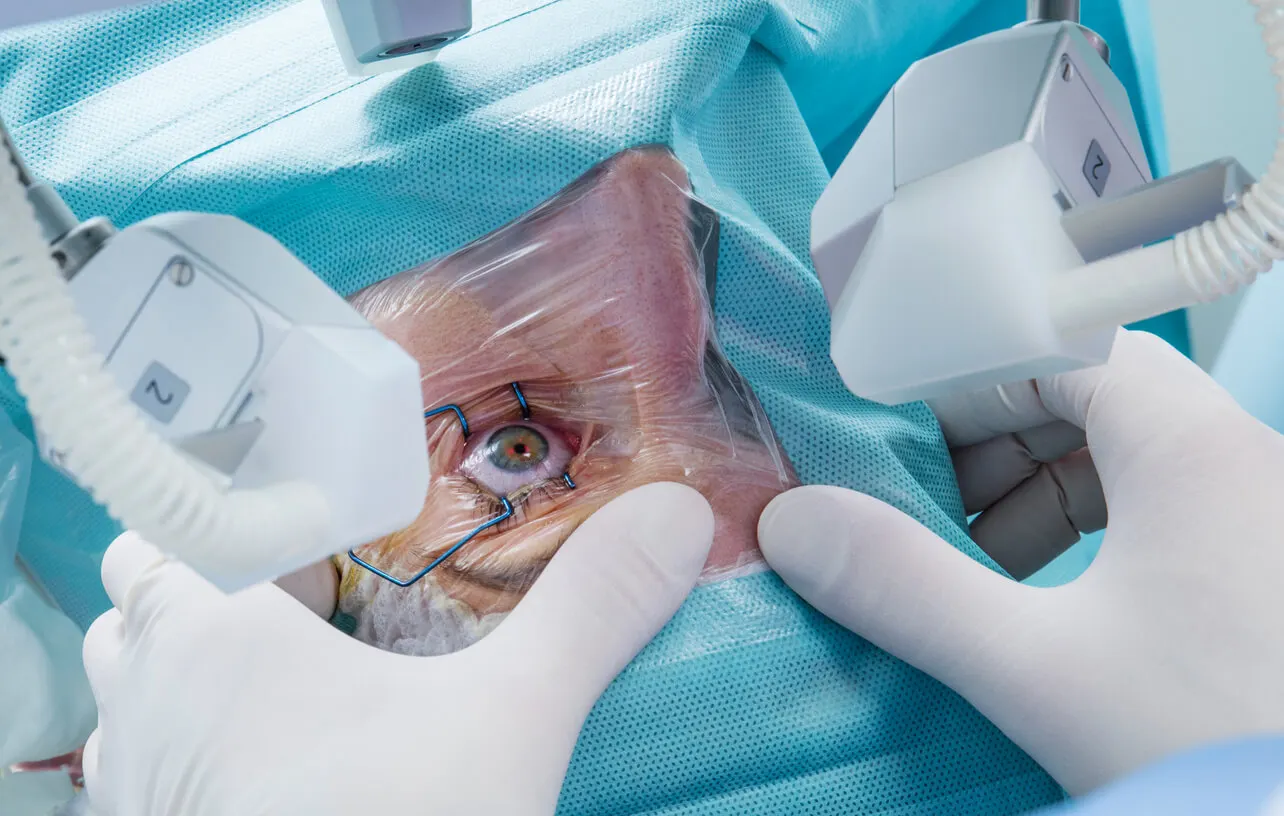8 Side Effects of Cataract Surgery You Should Know About


Written and verified by the doctor Maryel Alvarado Nieto
Cataract surgery is one of the oldest and one of the most common procedures in medical practice, although it does sometimes cause some side effects. From the first attempts to restore vision in cataract patients to the current state-of-the-art techniques, the number of complications of this surgery has been reduced. However, some of them still persist and show up in rare cases.
Cataracts are one of the main ophthalmologic conditions of the elderly. In this condition, varying degrees of opacity appears in the crystalline lens, a natural intraocular lens that allows light to pass through to the retina to observe the world around us. Vision is possible thanks to the transparency of the crystalline lens, which is why opaque areas generate a decrease in visual acuity.
Adequate preparation is key to preventing cataract surgery side effects
Preoperative evaluation is essential for any surgery. This is also the case for ophthalmology.
A thorough assessment allows doctors to recognize the risk factors of each patient and anticipate various situations both during surgery and during recovery from surgery. Similarly, preoperative evaluation is essential to choose the best surgical approach in each case.
There are conditions that should be taken into account, since they increase the probability of side effects in cataract surgery. Therefore, being able to identify them is vital for the success of the procedure. Also, the clarity with which information is provided to the patient avoids unrealistic expectations.
Among the conditions that increase the risk of complications in cataract surgery are the following:
- Glaucoma
- Diabetic retinopathy
- Arterial hypertension
- Pseudoexfoliation syndrome
- Pupillary dilation defects
We think you may also enjoy reading this article: What Colors Look Good on You According to Your Skin, Hair, and Eyes
Also, during the surgery itself, some unwanted situations may occur that can impact the results. These complications are even less frequent and depend in part on the technique used.
However, the higher probability of occurrence in patients with risk factors shows that intraoperative complications are directly related to the preoperative situation.
Bearing this in mind, let’s take a look at the side effects that are most frequently recorded in cataract surgery. The first 5 that we’ll tell you about are after the surgery, and the final three refer to complications that may already appear at the time of the intervention.

1. Posterior capsule opacity (PCO)
This is the main complication that may occur after cataract surgery. It causes a decrease in visual acuity by triggering blurred vision. The posterior capsule of the lens is one of the structures left behind during extraction surgery, as it supports the intraocular lens.
Origin of the complication
Posterior capsule opacity occurs when cells that are shed during the procedure are retained residually. The migration of these elements into the capsule, which has a shape that provides transparency, hinders the passage of light.
Correcting the side effect
Capsulotomy using YAG laser technology is the first choice of treatment for posterior capsule opacity. However, this is a procedure that is performed if the visual disturbance is significant, which is evident with a slit lamp.
The results are excellent, but like any procedure, it has some risks:
- Transient increase of intraocular pressure
- Intraocular lens subluxation
- Macular edema
Like this article? You may also like to read: How to Use Tea Bags to Improve Circles Under Your Eyes
2. Increased intraocular pressure
Another cause of blurred vision after cataract surgery is increased intraocular pressure (IOP), which is usually transient. The causes include the molecular weight of the material used in the intervention, the location of the intraocular lens, and the use of steroid drops after surgery.
The increase in IOP can be prevented by postoperative indication of intraocular pressure-lowering drugs, either orally or topically. However, patient follow-up is critical, as some require prolonged antiglaucoma medication and even another surgery.
3. A foreign body in the operated eye
A more frequent complication is the presence of an intraocular foreign body after cataract surgery. The material of the foreign body may vary, with the following being the most common:
- Eyelashes
- Metallic debris
- Cotton fibers
- Plastic debris
- Cellular debris from the operation
- Fragments of the intraocular lens
A thorough review of the equipment, both preoperatively and at the completion of surgery, as well as a thorough postoperative examination, reduces the frequency of this complication. In general, removing the foreign body is recommended, since it can trigger major problems depending on the type of material and its location:
- Infections
- Ocular hypertension
- Fragment mobilization injury
4. Retinal detachment
Following cataract surgery, there’s an increased risk of retinal detachment compared to the general population. Symptoms include the presence of small spots floating in the visual field, known as floaters (myodesopsias), the sensation of light flashes (photopsia), and progressive loss of vision in the form of a curtain.
These symptoms should be urgently evaluated by an ophthalmologist.
5. Endophthalmitis: One of the most feared complications
One cause of pain and red-eye is endophthalmitis, an infection of the eyeball. This occurs when microorganisms enter through the surgical incision, colonizing the interior of the eye.
Aseptic measures are fundamental in its prevention, as is the indication of topical antibiotics prior to surgery. Treatment should be started immediately, since this condition affects a person’s vision.
6. Capsular rupture after cataract surgery
Although this is one of the side effects described during cataract surgery, and the first of the 3 that are intraoperative, this complication is quite unusual. Laceration of the posterior capsule by the instruments used during the procedure and even trauma generated when placing the intraocular lens may cause this.
This is a serious complication, since the repair is a surgical challenge, especially because it usually occurs in patients with difficulty managing baseline conditions. In addition, capsular rupture can lead to other undesirable effects, such as retinal detachment and macular edema.
7. Zonular dialysis
Zonular dialysis is a rare complication in cataract surgery, as it’s more frequent in patients with existing risk factors. To repair this zonular lesion, the placement of a tension ring to fix the lens is recommended.

8. Suprachoroidal hemorrhage and cataract surgery
A rare complication in today’s surgeries is suprachoroidal hemorrhage. Rupture of blood vessels by the incision leads to increased intraocular pressure with ocular contents leaking out through the wound itself. Stopping the bleeding immediately during surgery is key.
Other side effects of cataract surgery
Although rare, intraoperative complications lead to a poor outcome of the procedure. This is why preoperative assessment is so important.
Similarly, a higher frequency of such complications during cataract surgery has been corroborated in developing countries. This is due to the technological limitations of these populations and the restricted access to training and updating.
As in any surgical procedure, symptoms may appear during the recovery period due to the manipulation of the ocular structures. These include pain, the sensation of having something in your eye, and dry eye. Also, the medication administered may trigger transitory adverse effects.
The persistence of symptoms or their intensity is a reason for consultation with an ophthalmologist.
All cited sources were thoroughly reviewed by our team to ensure their quality, reliability, currency, and validity. The bibliography of this article was considered reliable and of academic or scientific accuracy.
- Chan, E.; Mahroo, O.; Spalton, D.; Complications of Cataract Surgery; Clinical and Experimental Optometry; 93 (6); 379 – 389; 2010.
- Villaseñor, J.; Hernández, F.; Martínez, C.; Villar, J.; Síndrome de Pseudoexfoliación y Catarata: Resultados Visuales en Cirugía de Catarata; Revista Mexicana de Oftalmología; 80 (2): 86 – 88; 2006.
- Benito, B.; Narvaez, C.; Jódar, M.; Sáenz, F.; Santos, E.; Cueros Extraños Intraoculares tras Cirugía de Catarata; Sociedad Española de Oftalmología; 2018.
- Ferro, J.; Endoftalmitis post Cirugía de Cataratas: Prevención y Tratamiento; Archivos de la Sociedad Española de Oftalmología; 78 (8); 2013.
- Galvis, V., Wong, C., Espinoza, J. V., & Tello, A. (2007). Subluxación de un lente intraocular fáquico y catarata secundaria: informe de caso. MedUNAB, 10(2), 137-140.
- Diez, J. V., Fernández, F. H., Franco, C. M., & Kuri, J. V. (2006). Síndrome de pseudoexfoliación y catarata: resultados visuales en cirugía de catarata. Revista Mexicana de Oftalmología, 80(2), 86-88.
This text is provided for informational purposes only and does not replace consultation with a professional. If in doubt, consult your specialist.








